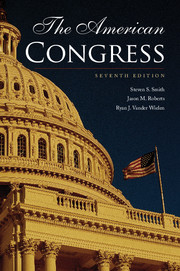Book contents
- Frontmatter
- Contents
- Preface
- Acknowledgments
- 1 The American Congress
- 2 Representation and Lawmaking in Congress
- 3 Congressional Elections and Policy Alignments
- 4 Members, Goals, Resources, and Strategies
- 5 Parties and Leaders
- 6 The Standing Committees
- 7 The Rules of the Legislative Game
- 8 The Floor and Voting
- 9 Congress and the President
- 10 Congress and the Courts
- 11 Congress, Lobbyists, and Interest Groups
- 12 Congress and Budget Politics
- Appendix Introduction to the Spatial Theory of Legislating
- Suggested Readings
- Index
- References
5 - Parties and Leaders
- Frontmatter
- Contents
- Preface
- Acknowledgments
- 1 The American Congress
- 2 Representation and Lawmaking in Congress
- 3 Congressional Elections and Policy Alignments
- 4 Members, Goals, Resources, and Strategies
- 5 Parties and Leaders
- 6 The Standing Committees
- 7 The Rules of the Legislative Game
- 8 The Floor and Voting
- 9 Congress and the President
- 10 Congress and the Courts
- 11 Congress, Lobbyists, and Interest Groups
- 12 Congress and Budget Politics
- Appendix Introduction to the Spatial Theory of Legislating
- Suggested Readings
- Index
- References
Summary
Election outcomes often motivate change in the organization and strategies of congressional parties. After the 2010 elections, Democrats lost their majority in the House and saw their Senate majority shrink to 53. As always happens when a party loses many seats, Democratic partisans wondered if new leaders would improve their chances next time. This time Democrats tended to blame the economy and the standing of a president of their party rather than their incumbent leaders, which set the stage for the continuation of Nancy Pelosi (D-California) as the House Democratic leader, although now as minority leader, and Harry Reid (D-Nevada) as Senate majority leader. Serious talk occurred about whether Pelosi would or should return as party leader, but no one challenged her and she wanted to continue. There was an important contest brewing among House Democrats between Steny Hoyer (D-Maryland), a moderate in politics and style, and James Clyburn (D-South Carolina), backed by some liberals, for the second-ranking leadership post in the party whip. The tension within the party was relieved, at least temporarily, when Pelosi proposed and the party created a new leadership position, Assistant Leader, for Clyburn.
On the Senate side, no one challenged Reid, but Reid gave Charles Schumer (D-New York) new responsibilities in response to criticism that party strategy and public relations had been in disarray in the previous Congress. Schumer, who refused Reid's offer to again make him the campaign committee chairman, was named chairman of the Democratic Policy Committee. In addition, Reid placed Schumer in charge of the party's more informal “war room,” where legislative and public relations strategies are set.
- Type
- Chapter
- Information
- The American Congress , pp. 127 - 170Publisher: Cambridge University PressPrint publication year: 2011



